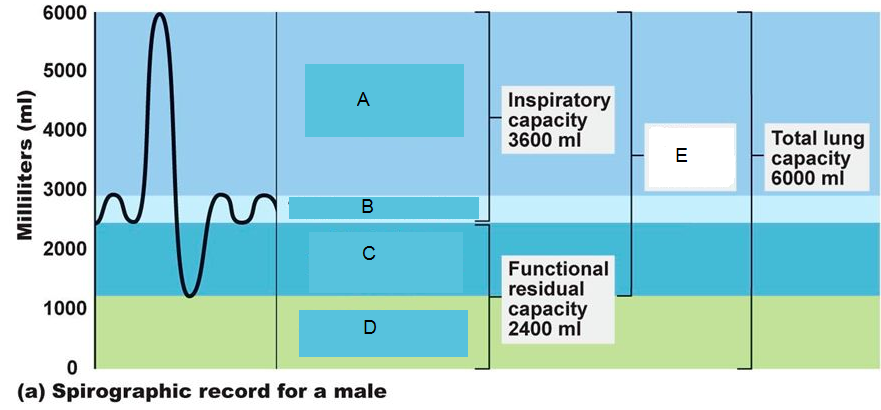During normal respiration, the ventral respiratory group located in the medulla oblongata:
1. Establishes the basic respiratory rhythm
2. Controls the switch off point of inspiration
3. Remains inactive
4. Excites chemosensitive zone neurons
Pneumotaxic centre which can moderate the functions of the respiratory rhythm centre is present at:
1. Pons region of brain
2. Thalamus
3. Spinal cord
4. Right cerebral hemisphere
The following statements refer to gas carriage by blood. Choose the correct statement:
| 1. | After leaving the lungs, each litre of blood contains about 20 ml of oxygen. |
| 2. | Haemoglobin is half saturated with oxygen when the PO2 is about 30 mm Hg |
| 3. | As the PCO2 rises, the affinity of haemoglobin for oxygen is increased. |
| 4. | Each litre of arterial blood contains about 50 mL of carbon dioxide. |
Study the spirograph and identify the correctly matched volumes from the codes given:

TV IRV ERV RV VITAL CAPACITY
1. A c B D E
2. A B C D E
3. B A C D E
4. C B A D E
Fibrous connective tissue builds up in the lungs causing them not to inflate properly, and actually deflating them is called:
1. chronic bronchitis
2. emphysema
3. pulmonary fibrosis
4. asthma
The C-shaped cartilaginous rings around the trachea are open posteriorly to:
(1) allow for expansion of the esophagus during swallowing
(2) allow the vocal cords to relax
(3) prevent food from entering the nasal cavity during swallowing
(4) prevent food from entering the trachea
The trachea is lined with
1. ciliated simple squamous epithelium
2. stratified squamous epithelium
3. pseudostratified ciliated columnar epithelium
4. pseudostratified squamous epithelium
When you hold your breath which of the following gas changes in blood would first lead to the urge to breathe?
(1) Falling O2 concentration
(2) Rising CO2 concentration
(3) Falling CO2 concentration
(4) Rising CO2 and falling O2 concentration
Lungs are made up of air-filled sacs, the alveoli. They do not collapse even after forceful expiration, because of
1. Residual Volume (RV)
2. Inspiratory Reserve Volume (IRV)
3. Tidal Volume (TV)
4. Expiratory Reserve Volume (ERV)
The partial pressure of oxygen in the alveoli of the lungs is
(1) equal to that in the blood
(2) more than that in the blood
(3) less than that in the blood
(4) less than that of carbon dioxide






